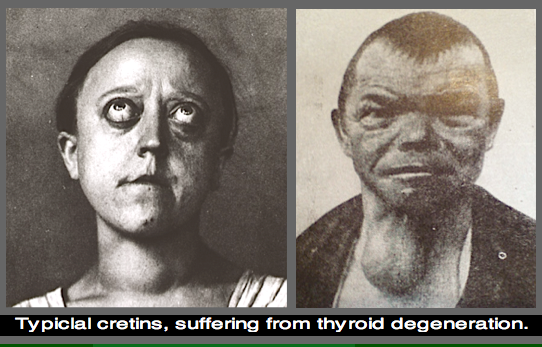10 October | Uncategorised | admin
LOW-IODINE AND HIGH-FLUORIDE ENVIRONMENT
FLUOROSILICIC ACID:
Mixture of Dozens of Elements & Compounds
The goitre prevalence was 82% and dental
fluorosis of 16.00%. The average water
iodine level was 0.96 mg/l and
that of fluoride 0.34 mg/l.
THE RELATIONSHIP OF A LOW-IODINE &
HIGH-FLUORIDE ENVIRONMENT TO
SUBCLINICAL CRETINISM *
IN XINJIANG (China)
by
Lin Fa-Fu, Aihaiti, Zhao Hong-Xin,
Lin Jin, Jiang Ji-Yong, Maimaiti, & Aiken.
Original ⇓ plus many ⇓
MORE POSTS
Extract:
…Xinjiang Institute for Endemic Disease Control and Research;
Office of Leading Group for Endemic Disease Control of Hetian Prefectural Committee of the Communist Party of China; and County Health and Epidemic Prevention Station, Yutian, Xinjiang.
.
Cretinism in iodine-deficiency areas is well known, yet the milder forms of somatic and psychomotor maldevelopment and thyroid dysfunction caused by iodine deficiency may be more difficult to detect. DeQuervain, in 1936, called this milder form “semi-cretinism,” while in 1980 Laggasse used the term “cretinoidism.” It was formally named “subclinical endemic cretinism” at a symposium on subclinical cretinism held in Xinzhou, Shanxi province in 1985.
Currently, attention is being focused on these disorders in China and abroad. The Hetian prefecture in Xinjiang has reportedly been one of the Asian areas most severely affected by iodine deficiency disorders (IDD).
During the period 1987-1989, we made a systematic survey of subclinical endemic cretinism in this district under a UNICEF aid Project.
.
Materials and Methods:
General conditions and selection of affected areas –
The entire region of Xinjiang in central Eurasia is affected by iodine deficiency. The study area, located between the southern border of Tarim basin and the northern slope of Kunlun Mountains, is arid with sandy soil and an annual precipitation less than 50 mm. The cultivated alluvial plain extends from south to north with a steepening gradient. The geographical distributions of endemic goiter and endemic fluorosis are characterized by marked vertical zones. The inhabitants are of lower socioeconomic status, with an annual mean income of about 200 yuan (RMB) per person.
Area with high fluoride and low iodine levels (Area A) –
In the township Xinyuan in the lower reaches of Kliya river in the county of Yutian, north of the highway, we examined 250 schoolchildren, aged 7-14 years. The goiter prevalence was 91% and dental fluorosis 20.80%. The average level of iodine in drinking water was 5.21 mg/l, and that of fluoride 0.88 mg/l.
Area with low iodine level (area B) – In the townships of Langan and Jiayi in the alluvial plain before the mountains and to the south of the highway, we examined 256 schoolchildren, aged 7-14 years. The goiter prevalence was 82% and dental fluorosis of 16.00%. The average water iodine level was 0.96 mg/l and that of fluoride 0.34 mg/l. …
.
* CRETINISM is the condition wherein the child has severely stunted physical
growth due to untreated congenital iodine deficiency while myxoedema is a
form or cutaneous and dermal oedema due to increased deposition
of the connective tissue components. The subcutaneous tissues
are seen in hypothyroidism and Grave’s disease.
EFFECT OF HIGH-FLUORIDE WATER
ON INTELLIGENCE IN CHILDREN
F. IQ Children China
Reports of this problem are surfacing in
parts of Australia where water fluoridation
has been operating for many years!
Hypothyroidism Fluoride and Iodine
.






